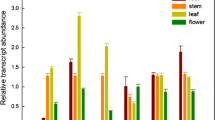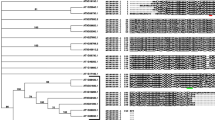Abstract
Glyoxalase II is part of the glutathione-dependent glyoxalase detoxification system. In addition to its role in the detoxification of cytotoxic 2-oxo-aldehydes, specifically methylglyoxal, it has been suggested that the glyoxalase system may also play a role in controlling cell differentiation and proliferation. During the analysis of a T-DNA-tagged mutant of Arabidopsis we identified the gene for a glyoxalase II isozyme (GLY1) that appears to be mitochondrially localized. The cDNA encoding a glyoxalase II cytoplasmic isozyme (GLY2) was also isolated and characterized. Southern blot and sequence analyses indicate that glyoxalase II proteins are encoded by at least two multigene families in Arabidopsis. Escherichia coli cells expressing either GLY1 or GLY2 exhibit increased glyoxalase II activity, confirming that they do, in fact, encode glyoxalase II proteins. Northern analysis shows that the two genes are differentially expressed. Transcripts for the mitochondrial isozyme are most abundant in roots, while those for the cytoplasmic isozyme are highest in flower buds. The identification of glyoxalase II isozymes that are differentially expressed suggests that they may play different roles in the cell.
Similar content being viewed by others
References
Allen R, Lo T, Thornalley PJ: Inhibitors of glyoxalase I: design, synthesis, inhibitory characteristics and biological evaluation. Biochem Soc Trans 21: 535-540 (1993).
Allen R, Lo T, Thornalley P: Purification and characterization of glyoxalase II from human red blood cells. Eur J Biochem 213: 1261-1267 (1993).
Ball J, Vander Jagt D: S-2-hydroxyacylgluthathione hydrolase (glyoxalase II): active sitemapping of a nonserine thiolesterase. Biochemistry 20: 899-905 (1981).
Concha N, Rasmussen B, Bush K, Herzberg O: Crystal structure of the wide-spectrum binuclear zinc B-lactamase from Bacteroides fragilis. Structure 4: 823-836 (1996).
Deswal R, Chakaravarty T, Sopory S: The glyoxalase system of higher plants: regulation in growth and differientation. Biochem Soc Trans 21: 527-530 (1993).
Doyle J, Doyle J: Isolation of plant DNA from fresh tissue. BRL Focus 12: 13-15 (1990).
Espartero J, Sanchez-Aguayo I, Pardo J: Molecular characterization of glyoxalase-I from a higher plant; upregulation by stress. Plant Mol Biol 29: 1223-1233 (1995).
Feldmann KA: T-DNA Insertion Mutagenesis in Arabidopsis: Mutational Spectrum. Plant J 1: 71-82 (1991).
Henikoff S: Unidirectional digestion with exonuclease III creates targeted breakpoints for DNA sequencing. Gene 28: 351-359 (1984).
Laemmli EK: Cleavage of structural proteins during the assembly of the head of bacteriophage T4. Nature 227: 680-685 (1970).
Lo T, Westwood M, McLellan A, Selwood T, Thornalley P: Binding and modification of proteins by methylglyoxal under physiological conditions: a kinetic and mechanistic study with N-acetylarginine, N-acetylcysteine, and N-acetyl-lysine and bovine serum albumin. J Biol Chem 269: 32299-32305 (1994).
Lyles G, Chalmers J: The metabolism of aminoacetone to methylglyoxal by semicarbazide-sensitive amino oxidase in human umbilical artery. Biochem Pharmacol 43: 1409-1414 (1992).
Makaroff CA, Palmer JD: Extensive mitochondrial specific transcription of the Brassica campestris mitochondrial genome. Nucl Acids Res 15: 5141-5156 (1987).
Nakai K, Kanehisa M: Aknowledge base for predicting protein localization sites in eukaryotic cells. Genomics 14: 897-911 (1992).
Norton S, Elia A, Chyan M, Gillis G, Frenzel C, Principato G: Inhibitors and inhibition studies of mammalian glyoxalase II activity. Biochem Soc Trans 21: 545-549 (1990).
Nortron SJ, Talesa V, Yuan W-J, Principato GB: Glyoxalase I and glyoxalase II from Aloe vera: purification, characterization and comparison with animal glyoxalases. Biochem Int 22: 411-418 (1990).
Novagen: pET System Manual. Novagen, Madison WI (1995).
Papoulis A, Al-Abed Y, Bucala R: Identification of N2-(1-carboxyethyl)guanine (CEG) as a guanine advanced glycosylation endproduct. Biochemistry 34: 648-655 (1995).
Paulus C, Knollner B, Jacobsen H: Physiological and biochemical characterization of glyoxalase I, a general marker for cell proliferation, from a soybean cell suspension. Planta 189: 561-566 (1993).
Peirson BN, Owen HA, Feldmann KA, Makaroff CA: Characterization of three male-sterile mutants of Arabidopsis thaliana exhibiting alterations in meiosis. Sex Plant Reprod 9: 1-16 (1996).
Phillips S, Thornalley P: The formation of methyl glyoxal from triose phosphates. Investigation using a specific assay for methyl glyoxal. Eur J Biochem 212: 101-105 (1993).
Pompliano D, Peyman A, Knowles J: Stabilization of a reaction intermediate as a catalytic device: definition of the functional role of the flexable loop in triosephosphate isomerase. Biochemistry 29: 3186-3194 (1990).
Rahman A, Shahabuddin A, Hadi S: Formation of strand breaks and interstrand crosslinks in DNA by methylglyoxal. J Biochem Toxicol 5: 161-166 (1990).
Ray S, Ray M: Isolation of methyl glyoxal synthase from goat liver. J Biol Chem 256: 6230-6234 (1981).
Ridderstrom M, Saccucci F, Hellman U, Bergman T, Principato G, Mannervik B: Molecular cloning, heterologous expression, and characterization of human glyoxalase II. J Biol Chem 271: 319-323 (1996).
Sambrook J, Fritsch EF, Maniatis T: Molecular Cloning: A Laboratory Manual, 2nd ed. Cold Spring Harbor Laboratory Press, Cold Spring Harbor, NY (1989).
Sanger F, Nicklen S, Coulson AR: DNA sequencing with chainterminating inhibitors. Proc Natl Acad Sci USA 74: 5463-5467 (1977).
Sieburth LE, Meyerowitz EM: Molecular dissection of the AGAMOUS control region shows that cis elements for spatial regulation are located intragenically. Plant Cell 9: 355-365 (1997).
Studier F, Rosenberg A, Dunn J, Dubendorff J: Use of T7 RNA polymerase to direct expression of cloned genes. Meth Enzymol 185: 60-89 (1990).
Sutton B, Artymiuk P, Cordero-Borboa A, Little C, Phillips D, Waley S: An X-ray-crystallographic study of β-lactamase II from Bacillus cereus at 0.35 nm resolution. Biochem J 248: 181-188 (1987).
Talesa V, Rosi G, Contenti S, Mangiabene C, Lupattelli M, Norton SJ, Giovannini E, Principato GB: Presence of glyoxalase II in mitochondria from spinach leaves: comparison with the enzyme from cytosol. Biochem Int 22: 1115-1120 (1990).
Talesa V, Uotila L, Koivusalo M, Principato GB, Giovannini E, Rosi G: Isolation of glyoxalase II from two different compartments of rat liver mitochondria. Kinetic and immunochemical characterization of the enzymes. Biochim Biophys Acta 993: 7-11 (1989).
Thornalley P: The glyoxalase system: new developments towards functional characterization of a metabolic pathway fundamental to biological life. Biochem J 269: 1-11 (1990).
Thornalley P: The glyoxalase system in health and disease. Mol Asp Med 14: 287-371 (1993).
Thornalley PJ: Pharmacology of methylglyoxal: formation, modification of proteins and nucleic acids, and enzymatic detoxification: a role in pathogenesis and antiproliferative chemotherapy. Gen Pharmacol 27: 565-573 (1996).
Uotila L: Purification and characterization of S-2-hydroxyacylglutathione hydrolase (glyoxalase II) from human liver. Biochemistry 12: 3944-3951 (1973).
Vallee B, Auld D: Zinc coordination, function, and structure of zinc enzymes and other proteins. Biochemistry 29: 5647-5659 (1990).
Vander Jagt DL: Glyoxalase II: Molecular characteristics, kinetics and mechanism Trans Biochem Soc Gr Brit 21: 522-527 (1993).
Verwoerd T, Dekker B, Hoekema A: A small-scale procedure for the rapid isolation of plant RNAs. Nucl Acids Res 17: 2362 (1989).
Author information
Authors and Affiliations
Rights and permissions
About this article
Cite this article
Maiti, M.K., Krishnasamy, S., Owen, H.A. et al. Molecular characterization of glyoxalase II from Arabidopsis thaliana. Plant Mol Biol 35, 471–481 (1997). https://doi.org/10.1023/A:1005891123344
Issue Date:
DOI: https://doi.org/10.1023/A:1005891123344




